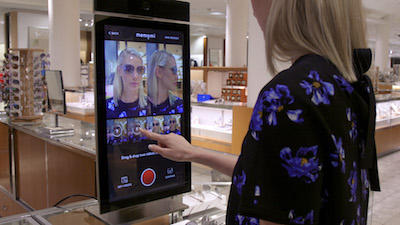Seven percent of personal luxury goods sales are made via ecommerce today, but online retail will represent 12 percent of the luxury market by 2020, according to projections from the Boston Consulting Group.
About six out of every 10 luxury purchases currently are influenced by digital channels, as social media, a brand’s Web site and mobile feed into buying decisions, whether the transaction is completed online or in-store. While many luxury brands have been avoiding the shift toward digital that many of their mass counterparts have made, BCG warns that the business models of digital laggards will no longer suffice in today’s market.
"Historically, product, artisanship, quality, creativity and the dream or aspiration created by the designer or steward of the brand was sufficient to motivate consumers to seek out the product and brand," said Christine Barton, senior partner and North American luxury lead at BCG and co-author of the report. "In many instances, if that experience was exclusive or even difficult, all the better in terms of the brand mystique and appeal.
"[It is] less true now of even luxury consumers who are 35 years old and younger," she said. "They, as well as some of their boomer counterparts, in particular, are spending away from personal goods toward experiences. They are more diverse generations in many populations, like the U.S., for example.
"Generally speaking, their values and beliefs are more social and inclusive. Their shopping behaviors and preferences are distinct from older consumers in that they are confident shoppers, preferring convenience, ease, immediate gratification, range, customization, self-service even at luxury price points."
BCG’s report is based on a survey of about 10,000 consumers in 10 countries and interviews with luxury industry leaders.
Growth plan
Rather than looking at digital as a threat, BCG points out that it can be a boon to the luxury industry. Digital holds with it opportunities for personalization and reaching a wider geographic clientele.
Whereas luxury brands drove growth previously by expanding their physical footprint into emerging markets, these hot markets have cooled their spending, requiring brands to look elsewhere. Digital channels enable brands to acquire and retain new clientele.
"Digital, for example, through analytics and segmentation, allows luxury brands and retailers to have so-called precision—or segmented—and personalized dialogue and communications with current and potential customers, which is consistent with individualized, special, intimate, rich interactions," Ms. Barton said.
"In other words, not all communications or offers need to be public or broadcast," she said. "On the other hand, when a brand or designer is launching and looking to build excitement, energy or awareness, social media allows broad reach and engagement.
"The digital and attendant analytic capability is required, whether it is primarily applied to better know, anticipate and deepen existing relationships or to attract entirely new clients or, ideally, to both purposes."
Digital touch points, however, challenge the exclusivity and control that luxury brands have established over decades or centuries. With the touch of a button, consumers can check a price or share their thoughts of a brand to the world.
This is especially true of millennials, who will be luxury’s buyers in the future. They are more apt to share their opinions about a purchase, with 60 percent posting reviews, 60 percent posting about products and 45 percent checking prices via a mobile device, often while they are shopping in a bricks-and-mortar environment.

Neiman Marcus' Memory Mirror
Fifty-eight percent of all luxury sales are the result of online channels, leaving only 42 percent of purchases that are driven exclusively by in-store interactions.
Showing the importance of omnichannel, about four in 10 luxury sales are completed in-store after online research, while 9 percent are bought online after first viewing products in-store.
While millennials are eager adopters of digital, their generation is not alone.
Although 86 percent of millennial luxury buyers want omnichannel interactions from brands, 75 percent of baby boomers say the same.
Additionally, in markets such as Japan and Russia, it is the older clientele that buy the most online.
The United States and the United Kingdom boast the most digitally mature luxury shoppers, with two thirds of luxury customers using some form of online channel to facilitate their last purchase.
Meanwhile, France and Italy hold onto the in-store experience more than their peers.
"Consider that globally 60 percent of luxury purchases are digitally influenced," Ms. Barton said. "Generally speaking, most luxury purchases start with knowing upfront the category the shopper wants to purchase.
"Fifty percent of men also know the brand that they will likely end up buying, although less for younger men," she said. "Only 40 percent of women know the brand upfront before purchase. Only 10 percent have the exact item in mind before purchase. So, that's a lot of room to influence the ultimate purchase.
"To do so, as a luxury brand or retailer, you have to intersect the consumer where she or he is digitally or physically. You also have to be able to quickly parse her motivation. For example, to be inspired, to learn, to buy, to receive service. And you have to stay true to her motivation in that interaction, all while influencing her."
Crossing channels
Eighty percent of luxury consumers desire an omnichannel experience from the brands with which they shop.
Topping their priorities is integrated delivery service, followed by having consistent promotions, regardless of channel and a consistent brand image.
Just as with advertising campaigns and retail design, touch points have the capacity to heavily affect a shopper’s perception, in either a positive or negative direction.

Hugo Boss On Demand
More luxury consumers are making their online purchases from marketplaces and department stores as the population buying from brands’ direct-operated stores has declined.
Not only is this cause for brands to make their own site a more rewarding experience, but brands should also ensure that multibrand ecommerce platforms deliver an on-brand service.
When it comes to omnichannel retailing, department stores perform better, on average, than their monobrand peers, according to a recent report by ContactLab and Exane BNP Paribas.
Multibrand retailers as a whole are reaching 50 percent of their full omnichannel potential, higher than the collective mega brands such as Louis Vuitton and Gucci and beating out premium, jewelry and high-end labels. Consumers who shop both in-store and online spend 50 percent more in a year than those who buy in bricks-and-mortar boutiques alone, making it financially smart to create an omnichannel shopping experience for clients (see story).
Rather than looking at ecommerce and digital as competitors to the traditional bricks-and-mortar store, retailers should think of them as complementary channels, according to panelists speaking at a recent Fashion-Culture-Design event.
During the “Who Owns the Future of Retail?” session June 9, insiders weighed in on everything from the state of the mall to the engagement opportunities that exist for brands within the physical store. Consumers now have practically unlimited options, giving them the control in the retail relationship, and making a point-of-view and differentiation all the more important (see story).
In a nutshell, for luxury brands and retailers, embrace a digital orientation at the top, BCG's Ms. Barton said.
"Like most transformative capabilities, digital and analytic mindset cannot solely be pushed from the bottom up," Ms. Barton said. "It requires executive leadership and pull.
"Consumer insights, even analytic ones, can constructively co-exist with creative and visionary skillset, and, in fact, integrated right, can actually free up designer, creative and marketer time from things that matter less," she said.
"Chief marketers should scrutinize for 2017 how they are spending their marketing budgets between traditional and digital media and their spend within digital. In personal goods categories, 25 percent of budgets today are spent on digital marketing, with leaders spending 50 percent of marketing budgets on digital media."
{"ct":"M+5pEcj5XXgPoCMn6Qq\/WXS5EAULwPJ\/uzDlKnYgZbkqQyrxBJ7fOPiyYPpEJ3O9F8Fr6CcGA8UNhtE5X0tBuuTV5j2Kktxm3ACQem4DePVbJGtFck1eELtQ5JCmo3XVmUxJI6ArwYWdvzoiXQr7\/gKpT4WkkJhTT5FoOxetIWWnKddILaAKrAVZ7RGFckYEC1Ln\/VLg1rp8DGiydOgAIx95GKf\/pOM6NYK39OON8DBn7Or052J5YoV20vtvx+dsqtgI6jfd0wW56ZmK6wc6gFmyuLOPirbOE6wBR4IU7CDFFvJLmeJ1g6Qkc4KPOblDl3HZTv05xzTsT3yEMs+dXILz3HxleawL+dJDXg0nlTC4p2INVd7GQQwP6jNNqlTNPERMS+H1Yl46I3jELRhXKMAIexrLnZIOAvb1tUtfkjz3WU6CoxwvuUO\/VsT2vm\/yg25omcHImyXaKwu9XlZs\/Wh1UBZnU4arEpypu3D1qgce1SW+u1LwwypoAuqkmKINQngPyxHh9aKt+v\/2JtYNp\/RbGKh\/5egmJ6Z82i\/kPwMwTnbJ05To5dKkygu1ailqc5aFgO1lmEE4og339EusgVIgUZQ+FXV4S+Fg4tdTu+FTsLJ+nJ+6WihK9ropCt3Tzmig3uoRTUO5D5oN+s59JYfGzcBbxnzqW4B5j1zNosM9RDF27Oc4qXpbK066nGTCyhosU5a9EU50ygZE3FxQ0jmlFgD6Y9GbcYw5EIZS8m2GgafemGIiRcigwjAlWvTvWITIYJjEgmz5Po8iOj1n3KYkblUBAb6CsQLdavEM+jtAGnPmWMQl4A3ssV+vDE3FZkoQsFO1pImBfFU1LG9joEB3Gzzc4gTUDAZFwenFRxf86pfECVQPys02HyvFoJfbrtIicTsolQDqKVC\/KYYlWQaywuiMA51+O5eR306fusaEYXaipTiGw7hKHL55TTimz7pvijilwKrpQ28rPab8xnrZCsiVrvGjc5goF7TRmVxg1wLL0AUNQ\/6vdgOpnpriNINiFiE1sSXDO5yoW\/kUq+hvIlrAm83bsxYGXAGaBjVToybNuUnQ\/fj9oLiPQxWFAd0ML\/np3WZb8TWfINAA7U7vRd2B3B9zWhdP2Est639emLgovAZCpJpj2IqtQ1CtVQu8paARS7MFkZ0gDPtcsBYokft7MSiAdDZ9X0ToUqEl2M7MMSqOZsHnvbEltzmM+FKrkR3PilEcByzMadwKe7MYrg+n\/n7jWeeOhpYa1HOELx24e1iClmfiQB2nUF1f7nK7EKIILmuv2h5pXen\/apPv+i3jvEZ5BRvnsijWWBDqpljf610fMeAGTuLuGAU89+eVYZ83tR9KFncNTXbeMk3bUud6NGqhrhofMOgPo9vIRkmcuEndLV+qeXZkRNBsIxXwJC5AcuMlTqtZz+tFnlw8wSlJDk7Z6\/AOytrqumYeMUEdShIvCpJhtie6JXFx4BT378p4ci1p8Rk7FzcMJXcNr4BHVAr1Dq+TJw4fUIuePzdrSCAvIVY5S+QZxjcATWIEAfis53JVErSmlimWwRCW1EbcUMr3Xa\/+S0Ov13BlY8VgwR35s3TNz5kMKzJUDRxc5pr1WoRi1GQv62aac47\/OZbWk\/h3SO7DQ3aBNBLS295sW9VwM8oDG5PyguHzjaTYqpkzg\/XbkcP0p\/RhDEq4x3lpkjQHs+kDymDKlhmXksit1B2hFwNlwgB2XVeOG1Zcgb2bmdR8lLc87b9l6xgz0blitWi8QrdNxPiXd5d1HXgbu19dHim+boYKvWAohNVg7N0oy1fnl2RgOMildDIa0FNNjpleQz9gHNXGFSu9RINwN7SvDhxVREZ+pv0rcqr1t2Lza9a3C7WVd1yaM\/ghO\/wuGen0dU8uHWc8eo6TMTB+GMXPGcDH\/Ky8XhOvbBskpsE7CtGbqPMwF4rjxM0tD4bBDzsoeqkjfBa2pjM9Hgt5T6xQZTj811VpJ8RMliXonaYD9tJVCOlxejOOAExnKn7P8K95styvxM98Q\/HHECZ6OgJ7q\/TrTkq2X+N75IiYZRqKNpXIyTu75OCtpj8xhZ5H5O2LTj7OMkkvLbRyh\/AzWqgiGfbUWFBF4BA1PtSpuefl+0YIwSvmtya5Fwxmw7VU6XkSjqk5lWNhwDDXrexnEKRCZpLEw+6hG\/XtZB79+nShud5JyWnzbZPd97hVdjQT3yjHUnH3jrds6dzE45HfZ7ze5YLG4QzzbOlrwTALvb+z\/bhYrmn3JUIqrGUVrWjnGb+e4sPq0EkwJ23CH4M6UQ2cT+P0DvQz2gwYvnIZZHq0lBDbCPJMO4s5WB9MkTQaT4U8O3ZW6bVDCT+PZCmi\/WmgaA+sZmqAN1crug0jCDN\/f5XIYWk9NaBAHGuOkdVx5g94+mIZQw5ZCTAsym\/oLTO6BNReIGUFHmijK5OiW\/zT348IdQL5Fu\/QAwPdgTtZRKlYD4DRpe7uMRmgFWylfJbpxlSNkSU0O19AgnZIQBpczl0jM13mvHaxsHoiP2tH6kuQYfx6X8bfzEc0wBbcHqHuACFHKjJlUaSPC9vJALS5qzjqStolvThoKQQRNaKh2XPVagHKoN4ag3uHfobQdMYlAJA\/UTGdsvo40bJTeKgg2l9rhn2v8x5bCyiEl983ykHkdx5XViwue5AyGFim9LbSJTdDqcwY6ftqVg\/PIDQqVdj3thNkSKsHDwKqISIj9jOon+j8R5J7ysXL3guEsKtuAPsQRk0pj2nHP57hmv7lZD62qo1DMDKUy1ZdwROwk9IGdoU8C2qQynX\/C\/q7GdNGF3LBADTjctbQlDA3UNxLNtEyzO8Iz3ZgY0vC88xjIljJAUqtuq82jz9NapsRzsbNNljhEg0HzdRTvUCRVy38EDhbB3p9bqdD7InFDqz4VgmLyizU9aN6vr4DlVjcXqzlr0rcW\/MSXjRuTFz6vdmTSxfZoO8xL2+0wI+YTcnfutxVkHcY4iaMvvJ4c6odWyCfwGSQb6aDl31g\/JuEgbKGwyi9pOz4AB9+y+1JPZS7OqTJmsTAae9Nomwm8sI+2gQxqlsUahD24QbcAs13TXBitEWZaYnYjwtkWinxg8CjjCH5gNC8iSKLh4LyTdkwpBloBfVAKj\/Yf5J13KZLrM\/\/h49imaZ9dkqjElRvwo2EhPuQ1ZxtTgT8wlaAsO+Buq7Wdo9wNCoAasMvdmUkhnYxpssKRWjP7GntOOyCpU6HsBVyrAkSOpXH3FzitsjXPJx383j+k3Xc9QLDXxST2mEXKatYeyriIu4Bi7lPadLkW5mFpLa7EjjTWSRVHuLY+4tRao2QYJbnPB37Ls6ACKebHQ6nBJch3aBwKq9Y1QA69A+M1vjtDByLuAC6tNLlEa\/mWnRexOtnVBZB0rd\/iX1dIKjSp2Az2\/6509VgLIcj6wcybghojhQigERqigzdx2DH2B4CkklU7WmQYAR9BRmkJ7RDOE4XwdtOivd4r0YFAcjxVh0eWW1nlNoPZXpcnur\/6yWmte\/qV1QrDPFYKtamIOf+qxKnD3I9mZdZiI2BSRXzdP50vzZ0UokiyQuxqlyxHZsc5CtXOgtGFoBOH3IJTJEVwwqbToTug88bcTqACTYK\/\/Hf7WXejJb\/gTdIzfvu7wWereg+h5V37zfOranbwjmMvzouvBsMHPTW9sS1x2TEZbFya1hy48\/DgCQSiZLXsLrnO3mq0pIkUR+3ufyi1gkVsdeJt3j6DZEf17nMXHHEiIdPWFFmVVH243951WVkon\/uquFIQSEJSGrb9bBYKmOlbrQJTUBRcztwZ0MuKMgoMgGMUPb+BW4BiQZhgS2xiYYRrXOvRnyqBlW8B8ga9LRI2ya87AU1SYkYBWbHG9\/WGRwF9AQ69z\/2tZ49Zm7IMb0n1xSeI\/BE7nkmqM9zniHkd\/e9lmesxIirnAmx7onAJuAES06TCaJl1wtQf4IAiWo6SxeHCZLZgpRqkXmDUlUSb7fF8l9WorrYpM80gisIV3khW+XxN2Wx9Df14DnfYSiMgh3+kAT3vTUaNfAES3ObeQqggZEyhKnCnfxdhFCtBOj3I98ykEbl8lR3abLd4BruutH55pSS+8Y8rdzo0ABEBimTlfFcV15F9IlNlYFr3oVxwFr4IIzeN3R9iNS1wQyxAiPJp14Wu19egDaDrdS1t5WR3XiwowJlSFPTXBHutO\/+8WsWCudwQczgbw9Q\/Bo4zW6ncY8IrZKCb1qW8ZFWakbiaTyCwGs6YNF0gQbpmmoe+5rCdE\/OrRA0eyGp8zECVnlCdKq5PQ9vhC+Crh\/KMwvRl4QycLZ7pGPljHXfdWitD9uk++8Ou+\/cSPhF+7NNLWK5uqzslwlrIMF9Utf6UiK68FjUndExdo\/rONkB7uznJRPpUhNsSS5ddqOTqF2o\/Mq3No0WdJySglTD7cseWf9obaJCtlvq3ZgglYKzduskl3wHoL3BfTYqeU\/NRX\/bxUyhySpv51Asc7enxNDVy\/s5HQ54vmkkp+l8HsLcSJMXpiOMQGs4l0A9\/wQu4aVgkxbq1ZSxvwV6ie7cuHVZ5bPFLDPCbCn\/01utljAnBzjC+rbd2Ln6R18DNfkAh\/j9qRjtLsodwD\/4DzRyP6w4yCONfo28VjdNUJKFn8QsQHJapV5P\/ruXnZEQoNg9GkcLxxiCTGfmplgJPaprjqb4CeRrDcuOXSXAloMJulxlvRvpdO3trErxDac7JxH32vgkT0TwX2Jq8Ba16NREpLgm9PZ+7zyhcI24TOE2hcnTROtpqvfqT93idiwZYktOg9K2W1H54h7wNrkiYlhWLAn3PFSQ\/4zsNjYxfDZoKIlWLedk7mp\/bFNLJhFXmKU5mUj1ZvfHEgcOXOYMwkWwpTxcn4jtcM0V63+No6N9QVP1uQW+aGPK8eawMaiRylakDnRA2nSnM2o6aJy56kgyYD0kqB7U2K19pt6oz5v8oj0wryZiqzBCpjD9T1elqhGHyu7NQgqFn0cjRbvjt2bXmeBQvJOuCu1jYM\/lzPj\/c46t8m1hjf\/3iknMCpG7LsS4CV42iLXQanZNTxjlV9NUTOAHSRH2NgY\/1Y+CQtmp8R3DtRyyghqQnrFMIE0VsAQimChpxQGtroZYzgh\/Wy2Nn456c6shWocv6zM5cFz1i1O16+uiP3AZRYyMzia0\/UBuZyURRzCWbMAIspSQyf7CVxh77LuDhK5NhpltgJ0HBRbE56EW4ja1je8jmw+mLmXUedzlu0+\/SjisKSoJvuIayzFHfeWdSsm3h9W5BxbLQSjK+e0HjovZSHUEbEF22Uy5hH2ensh+GUGDbLxjYZ\/Yg5eNWwH3hfLByB\/bgqnmb7Y6srWPIvtH8irbK1jaK+crNpLvlQoQT51sksZYy4w5yPAZBfGJcz+d2wtQ4Zqf7zFZG6+A9dK+RT8aDLy4vEAtbF+toMkgmgJjLqOayWX5TZbqQIrPDDrlQUmxDZGK8dQvKSXQq\/KoYtiRFMcacOMlWbQrZulSuvmyp9iifLhJy48SAtg8HW389UqrV3xpZEEZtjcBRm99WKg0U1BMeSzrpWx06VQUZS9rVN885gkqtZHG6qKX1pzeTEx1WXi1MZR1sqxcZZfXruoacyfNr\/tht8sbFC2\/TsSm525U+B3JmIrnIiO\/zyjbhn8GYko\/BlaUWSQi1LWn47jAaQSHcf6kGzEswnPqkjBNlM0W2fYcsaB0P2itl5+TLOT397N0Leiho77LuZtocrQS5rOJjw9B5UhNP2vlTosNDSEGr1Pl0BYUkfFIR8VJnE0w0Hax7N+Tn5p8RN\/QOBu\/9k\/jWz6ItCXKYLVdXqmEvN8Q8MsyHY2tnKaNUcJj91JQcBYGCJ9hp0KJ3OYdMBdmIQNBbihgAfZ9wXnE5eM+mQHDfoyoxwXjMNmCVBcmjiKj86hDb+BPdOppClrWJ0KX+lyEoDisIHsePt+2ZdnKv+Awkl3CsXe3w6lT+\/v1\/yORkPERb8nVVE9KLGalu31x7h78CBzbyBXYzfSgpKfgkQgkmhJg10c6ascBuNPZhD6tjsdJl9xjU0GYKLTxH1BX68xI50PpbwhPqNU0rS2w0ySWWI4waKk7KvJjCwodCQez7++HZqgLA\/bBQiQfbsryyPtREFrR4bme\/Vvkve8P3pM9jKV5KRrDZTT81+vYf6DQTAEugsxKtLt7ecu3HQ4\/sPV3TzJ0Sjw4qwPPn4Q8R+yhZr1DqwsiVwu1nS\/VpAhMsdEMFaJSuNBrOLKCLnuidWINx6TBc6oH8FcKMZNIAUKUcyQeQOrRi0j6ba\/qDrqTWC5JWS9F43O5UfNn6rU45f5JgQPbmDNg\/nlL4t6uY3zHkbkjkUTJaWpIcms20wY6orrx1SYGe3z2coIX+oP2Ko5IYT9NhE8T538tvRXlMKyuEAWfOWEIPB5B7pe9ArgC\/1bn6\/4jFj7PS\/esWXTIdaeac+RbqUBOhWVpi60LL2QQPdsJf76e4+xmozcd4xTxBncohPRr4+t8TNnFVDkkpVkDrs8GaiCaQIILQ9aHcMumOV6BwEUOmzJwvGLh++PgQM+uwU4lneIkrNerAGFWCQTWctpSznXwt9IpryNHaedfYhl\/wMmZmof4IFR+vhSYS98Y21PPPYf8zis2Lc1leFpuvGLY7DUpRHitqr8P1R0dtdw832ko7fB+dpyFcM10dZ+u1Jz2HRO98buFo9ODPSrTARe8gocV4j6tmBMT57brqiIUX0AAc7MslFqGWVbUwF9ml\/I3iaabMoNIkf2F7WvgO3RHMpyHUU5YSCrYzJmE9\/sFBt99UoIAJL+y48wJnst6+Cp3riTnt+2qb81U6DBHzWG+QhzrZ6QFRd47fsj3NmTZ3kUcwe2rGQrwZ4UoQsgsLJ1\/1WDBwHFn41ug8zEWLLTBewM3lvgJq8YT+6Vhx3QLWDWz9M9oC\/8KizA0cR6vpkzJ4wtzvuQr6wXxu6tUOuGotZII1Zyab5TrEthDeCPVXVp2LAJyfQV6ppzETARhQ6wzktVnL75jrywX1vC431fvGbp14Py5ffENPr9xlM0WQomPIUgJ6qsmsdXaBdaFs4cJ1UHl8HyS6gjoGqD79sXYv9xwDrtvUN3TUHYJ1W3u8NCtqvMwwMnbcc7q4aFT1nnv\/OVz4B1I6ZvVg2\/1mMLjXAjG2h+zgFWwcC8Nqc8JcVPB8sy965mSY9akkZGeYY0+0imhuPwCLdeLDVksaiqhKX6DLxYwfHAr18khhEHrmXeJUgSD\/Ys6blbIhrNAPOvGZCeqMPC9oYVMJh1I3GVxQRB97b6WrpPWrOKMGZPngq50ngeVj3sy0V+52dYOsDvSQcogqftZmNtwphWAmHVa54XDdvcgFdzWVMCCenE0haGd1ToL9Ek5jyY8jvYT1IVu7rv8tbvEIGY5E0UaLAb2VB1M\/+kWVT+YULKwgjbgmiMT5263O4tul7WFdcaD8l8Zb\/DfbuURhAi4BV35HqILgguppL8KmMujQjNT3ohBmh1rO21uXp+p2sxOhiuhJSvYJe4S2VLW9PYPXELpFoXtJl7CWu2voQSw7G9n369erufhsXtHkjLkQdMaZbIBY7hVnia2xD+aE+MUVaKHTM+M68wO1Hcgq\/VY7h5cK4ZF0sot\/DJEcDIQOtp2rsWUPL58hJ02ZXZS4CIzzINkm\/ipXsKAu6nQr76lRkwVvhzqMtUZ19\/sEgIAad70E3nxxY6qd0l\/uA4eVu0c50geZZx8UGuVI8YaVKk3KCORnWPRyThbz14CBypvZd2\/LsX0QJx6EHIVggoklEBuZ15vqWeTfIBS5rEKG0XPVJ\/02yzIrsYT9yQBfgUt3lNgq\/N4CDwpR4m7H55LRJyFTUG8h1343SISGIN+OYebnFKrQEWc82A+YJJB2EySRfSYlPweLqt4B9AsDF5F+o8YfAqZfCoNHMdAmn9LI0+tLD17ouurzLiQEPBZRPkMVQ2eGwH87YPeYWSa11OfriCNYn0XLbp75aDI\/qIKs5rwJoWwMzpSbD8WN7uEojWhDpCSXcyJKS+pInkDqHG54TqYk7ebKK9rkByW8QrY1MiiwzBmBNyGQsdMQ9CQVAPoJTZwCTAZFRIkvlvn24BoUVELE9EgAdMFd9vccCS7ZkIIfVDAgZGPdnIuancgyCOHMNeO6WVyCeBawVEBF0r1\/ykgRnjXQPcWEHqGMGrsYmbVaQJX886CzIrRuHSqSI\/XrETd2QJX7CCHMLsUlaFAbAd+3PbPF31pkkISArWirU3bgV6yYuSRN2zeHQobAARcYxxtfMmS2nk9ys3vkut7xoTLcjV+LAavC6f+sqq51AhQL0cMRlmcrA8niEmA7j0s1R+Kg83VTVXSwbE\/bUEEqympBfBHW5h1H4yAj3xXmVh3hrn+WIFHtrlJmvRrhcTKonJ3sN9\/EjOMlmfOQEqvX0m4VOm9wanf7IMhzr\/96MVcvDStcYkNrBQQZng7efNCJbLgTACoHl9r45ZlnTf4UXl4UiUs\/Ps8FuWfaaiMOG9406Z5PgLjYAcvxIwFuRx9e1y02bjCcGNTPgiDMJbjGaFoCWAEXGfT4b7h4N8W2oDk4T98qrEI3VmxslaUa0is3+PIpn2aB8rBxgHH7in9xNDkr3i1o522EHbreQ0nyLy7\/APsKcWVQBrMLwNuo0mG4EBbdvLV4gOXzRPnj2ytFerQ7BdAu7I81pcFaYoRRhD6tknQDZPUro+DcwBHqT5jafQnTmKDLfUhMqgg54wSgq5rYVPbftB3Cr8Fk5aOUf9qdqkJW6sI19XuDj48btqJ6jwzll\/OhxS9biwQUaxUhF\/uGu1PkXOZf7k94ifS2NnSDjPAf\/vrNyKTZUJ0cBocZIcZZ8X\/in1llzfS9spk1GPRq4wwr5589aHgdUSlttVZRnGYsqLgEIz7VnbSlJOiQ+G7qOYKRo5Zr5YzY9rhFrvDlSHy2hM0ZLweuS1Hrb3v7sobi\/eemhPJVy6rxMsG63rkZwYrHwSNnpZB07Ye4nzCPLZZdpwpAr5ci6Qyd4gSHU7MJvjgkj\/j+rnhH+CX659EDROpeOkivZhynrLksfOBX3XnGfc4K833TRHiCSZnHxEMtVP3iLNM2hjbOBmuGgGuQoax140oe94WSRcE9NA7OgpsNG3q4si1jdPOGigL6QWp+uOLQ1DEhRg94RMz3v5swbDboaqCEEWaIqneDz8nsuB8z\/\/9Fu08V6hHh9BohKSz71e73Xo3F5FQkit4NfwSmzyofKDVHZvTh0RsFpw\/36+KYA62pbHfrd3ofLKnaY57iyHihIvFQRxEKU5WgFJiBuwfIprANSBzfzbLOsXKNPYjZZUN5IHioZ9h\/UY0aH4J21aCzL6jEQblTg\/oz7pfd8boHvIMVPLj9inn6FpaY8\/31hCCTvQL4vQorYbBi+nAHxCqVwz36E54Y2xULig25Te9IBW5uijuB7C5A43cp6MDr3IVpJtEb2KchkZly8zo6BrDbFErf57sgLXjddAqt3Hwe7QJ\/du1JGXBFzgLwstkcLjmJuO2glrRN+2HZBDHH4zCxbgupvS3TVtCgy1Hlc2vohz3nONvAGoPH22HllfyYneKHopEFn8w598pzp\/GjSXFjh5hLEA1bUcERxAHmfcTHDt8yuiuTrPpmcVqR5Rd7HtOrOPtPvoZMM3iXNberBoDtSYiLWhdzMy8ID6kVv4m\/aY9M2jMoZxz4l03aIFft8h7cgJtUiQK+Va3so8ytmD2F9ESr+CGJzi5SnMfYFejmedJ7furLUgb9Y2RILm9octkQla8fdhVFvLkIrD6BL3X48ha7cl71cNqrci93ujcDQjc6rwhnQbdQMyKpcSYeFhOmdr1\/QxRNTn+9zXlktjh1443O6tUx6xophSsJTrJmavVaHWnpvQCLK9srThs7ddyyut49W83SObp\/90s4idGmp6EAP4AN1mi9+GC0mjIKwNFkFAumdqLa9a44ZrcdnSvUw\/mFogViQUM4es0rk8NNOqJhcfxW4TlKQ2tIHX1r2KAEuNuxSM+q7kQm5szp0Vet3Xp\/puIe0je09+7C5NtWoyFixRPbV82luJM1ucwlbIsOOuBCygThk7G1k7q20bn+SguS0P+JNXbGiCNjI8OkLgfesVXpF2ntjHTEOqPiEVhszCVkBfnA5tSzzYCFxhPBHeLxJE131HJ17n8vgSefN\/i+ZYpHPOL5NQ10gNvty7F9cO1t5mK5k4ZNWn39UdpuafOleoZVwLrMb6J6gg9pYcznCHK8iCSv1oiue9rAAhNnbrsEGEyo3W2zSlVWh+uNapKhU3qzLVnoHXlXbKp7n43B+CEx\/fDlmSlddGCVo3GJ\/RP4hhh17knTO1sffOC7zXPoyrZORmiq+S2V8CPWZJl6YLnsY0fZn19Ghz3dC5iPlTmiHoukq4namWx8gZpCTw8fISlVQrbOI6QYJUVCfJZ2UC+2Cy55qtsuvP4eeNms2z7Hyl5vt\/SRImBCM1TxOyciTd1Vm8+ubHXAJpmEMMnroY+k+0xnRDLD\/p2JLlnATvWuYwUjf\/D6bJIzI7cxNJjmlkugEFM6DJUfTKX9\/RUxIaLzC9JZaPe+PXCkfYhQWBmPBM5kbpAw3Ro9dg9Wh\/zGgPHPoNp7Hmi4TcB8bvbSIMTMGirgqIQ8NdwJqMdjY9dcxKf0ILvHpbvlJq3XucEqV9\/rlPY4bJaOgu4fMwblgEOdJryAJTF9WhEAwHBVdKC7OwskZRxy8XLSUQMC8s3rnILYYYl8a\/v+snC2wuIsQda+NmqehBfBax+A5Y26eBFmbEJkwdyApLmX04f32Cp8Ddti+gF\/caaetdbPkAkSdffg69wzjRQXMHgxe\/SxG7U2v\/LAcl8pfsUx43D1UsfDEm+Z5fS4acrTl053T4gxP29Iv7gaR6vCxlg0Xnc1hs4UZFRt+tIRURAZN7li7OU7XPYdIztHQQz6Vx8+jXsc1IrsULQPaKzbL8x08jlusFkQoc3KWdGqFfl0onhSprrMSsEtqMa8TjkCTdxz4Td5sb7CMqFA12iqjuL8LyUkW4XRU3FJjQhgTrHNe7YClxl0YDBm9eT1u5rP5rRHhXZn8QexQGeSFmobGGQlKBXgvYtzrS0YZoEEw6U93QJ7pDk3PiN59dx34J4tTxr\/n8tpYm4o99ef1SUn3Kq+zJZDoD6W9IQtQiAIhNBWRc7QAppoesf9xarlgz\/0rzlQCjxND85X7AF\/28oJwPLn\/8YFfyK6XJLnNW6oVfT5AYM6Uc92bxtDaQjyKr2bv6u+VX\/gMmI66sQ3mtLDIFQ6B6JlT89fvh55D4wBDth67yW9\/UIMGZrqClohU1RPUmz\/w3aYMs\/ybCZg26Ak6McrOGUXH9l4HsD9Z\/JjoVCrwBAHiErqTXiHquRZnHSbh91TEDdGSH0ErtdNEtgXw12pad89A24tFq5zSq81rJZPmY1O19gFe5HnirO4RhjF0izO9SkGtyPPhOBi1bX6n+8IAY1VnetFxhcBhCYlON67oLWYaRELyQ8m0tgG0hvL7XpMM5exrc5oV6xA4EyL\/j6ANtD8w1H5tPuCeNwxr6b1JO+y1buxgWT1y1kzVB3uCQnvOc8HEvJtXlaV2ffe0b6Ezpdce0Y5BMof+MFn4YgluzGjfvuXcSjMJX8h\/5D9betVrp5i0OD4yOCJah3HNwyWvq1\/DnVL\/jpmN\/IbPknWqw+34+zfAzKHn0QWFgzdAiybNKKgB6HUHdFJoUSNT6u91vl8J2MkVZCmkjfE+dcQmtOIr9QW14UYhD3YC2Ffw9GXz1dbpA\/Xy0nq+94c4+EKYVHvH1wRNNiXroqXMV2vy6Kbvu8b+xlnhMj2OrI+12hi7playvpjUYM++Og+Lbnmu+tGNx2wfRhMmVAOlCodo1XDyhZdSnvIJGDQkRKq+Of4UaiATWatrbeaG1BhQFAAR+jTVERfQ76RFOmlHtqlAPAC0LvEXAhts7P53q5BJomhiKYk5DpC2WXI4CLrT9c4zJyRHLno8BMoTb0Tn1eo5iDclQKCrVbrmyDc7mFmn0XEZ9Z4YRC5EZQDmh8Vpmi\/UxM\/4gqHIBEOoJV\/oGqVl4zcga1IWAzrn4xkeDUoGGMhegZNhQhBqL8veLnAGx+iMRRuX\/wpMftlZWyiYOeoaY67tiHpkBbLTAz2lkhkSjSk4BLLHos3vw8Ac97SUTgw2gIjlK8yObm7yvnqiqPKy9zn42RTOibkg2UaAuKyyqD9gULxKiWkZqMvs\/GcrE0squP8S\/ULpGasdVYE9YIihC6ZeNgy4iZC85m5eTEHeTdljnRMi8BiKVdge4l9mDm1wOZUEzLeKiYK1GijntF4peMjH98b45fm0PfFWJcR38zStdN5IJl34JjlgQUBMLpTj1KHJWnmBpVyn73taDr\/Fz2C16f9y\/ZS\/DtpMxTtlw+ohLtnqd5yxbFKWOWTpeHeGcwFqls2L2SaMFc3wksw2QyxE2Lzn0SaTbHHGhXvTFy8AR7PlMQATb39Eff2VFXt6YdGJ3G3Gk78FuFQ1FXeefH0ZK2eWnGiucR36v0khLAcro5lXujz2kmzsIUNqX5KIRhg+9MhCP3fu7xqOlqPXMoZnvj143ISVdPCPRge1gFjQrJLSO7IGwYnYeLhaUWv5I1QFX6epDBmrBeyEN\/IKw4CidDFDAeVE7ZeQHcu5rdfuE7Ogb6Hl1kI0BUfX8hTIKVuwg6a\/URqDLBi0W\/LiJX\/dNCG3dcRqi128\/cQeer7KII2CoO6IpHu0O9FoMSw5RIPHRiePWEqvVlvM6H\/zW1i2FQmd3XVcpSL260M6XF1vt5ZV6f3GXBP9n2B+ZRjQP7QeaMcdi7YCDU9pO+scxUEgHvt4owhUdKaO9Q67iZMpRm\/9Bd1AWMkJo6Sfe9C1W7gOQTjHkFWkyPt60u2zCQIac2pIdjKdIJsZ+N3eNYl1yleqLq8ODsNQHg7SBgPb83gZtY5ubGomaDCuvIOsRu5pPr25lCRi7jQ1h0xhknxdR8qMRGeEAKmRYILz28qFodV+x5CX1kwG0BP8RlpfbETZgBYEbP5F+O9G905tlkPsulYeIuuY7U1NVuftBDfOHVEaucxn0XqnvfHoivsRJeJrUSQpgum628gFhkvUjoV36wS7lGQUbkhtxRvCc3YFYh0S2gHW8EPa13JnE2V458YvX6n3yJ9UG1nAm5BJNZ3CniCDkvrtSJAqOrRxkCW8NTrF7uU8Ha0+sBWWCDIImDWzP\/SI+87gw2H94cXmKjDFT\/syxjKBxSLgXfbaVmYzz7G+HIR4myvsOmrEGj93rAq7uBCPcvRNoOmL0BxyIM8jgt3yvYbekr0OCzpA\/BuDhpSdDWJ+FhG04ZaAkwsp1r2EPKexJOu5E7LvpdrMVGwFVKVXj32i+akx\/cuu03qcSZvFDwF6fu7eIWbXyTBstHUw4t8RKk8xSV","iv":"e9ca7d8a73e2ce8fc4d0cdee7cb7c1f8","s":"62121ddb98ff377b"}

 Image courtesy of Bloomingdale's
Image courtesy of Bloomingdale's